Research on Thermal Stability and Flammability of Wood Scob-Based Loose-Fill Thermal Insulation Impregnated with Multicomponent Suspensions
Abstract
:1. Introduction
2. Materials and Methods
2.1. Raw Materials and Composition of the Composites
2.2. Methods
2.2.1. Testing Methods
2.2.2. Statistical Methods
3. Results and Discussion
4. Conclusions
Author Contributions
Funding
Institutional Review Board Statement
Informed Consent Statement
Data Availability Statement
Acknowledgments
Conflicts of Interest
References
- Labaran, Y.H.; Mathur, V.S.; Muhammad, S.U.; Musa, A.A. Carbon footprint management: A review of construction industry. Clean. Eng. Technol. 2022, 9, 100531. [Google Scholar] [CrossRef]
- Khoshnava, S.M.; Rostami, R.; Zin, R.M.; Štreimikienė, D.; Mardani, A.; Ismail, M. The Role of Green Building Materials in Reducing Environmental and Human Health Impacts. Int. J. Environ. Res. Public Health 2020, 17, 2589. [Google Scholar] [CrossRef] [PubMed]
- Tang, W.; Huang, D.; Qiang, X.; Liu, W. Preparation of Hydrophilic and Fire-Resistant Phytic Acid/Chitosan/Polydopamine-Coated Expanded Polystyrene Particles by Using Coating Method. Coatings 2024, 14, 574. [Google Scholar] [CrossRef]
- Cetiner, I.; Shea, A.D. Wood waste as an alternative thermal insulation for buildings. Energy Build. 2018, 168, 374–384. [Google Scholar] [CrossRef]
- Zhou, X.-Y.; Zheng, F.; Li, H.-G.; Lu, C.-L. An environment-friendly thermal insulation material from cotton stalk fibers. Energy Build. 2010, 42, 1070–1074. [Google Scholar] [CrossRef]
- Lakreb, N.; Şen, U.; Toussaint, E.; Amziane, S.; Djakab, E.; Pereira, H. Physical properties and thermal conductivity of cork-based sandwich panels for building insulation. Constr. Build. Mater. 2023, 368, 130420. [Google Scholar] [CrossRef]
- Kymäläinen, H.-R.; Sjöberg, A.-M. Flax and hemp fibres as raw materials for thermal insulations. Build. Environ. 2008, 43, 1261–1269. [Google Scholar] [CrossRef]
- Muthuraj, R.; Lacoste, C.; Lacroix, P.; Bergeret, A. Sustainable thermal insulation biocomposites from rice husk, wheat husk, wood fibers and textile waste fibers: Elaboration and performances evaluation. Ind. Crops Prod. 2019, 135, 238–245. [Google Scholar] [CrossRef]
- Segura, J.; Montava, I.; Juliá, E.; Gadea, J.M. Acoustic and thermal properties of panels made of fruit stones waste with coconut fibre. Constr. Build. Mater. 2024, 426, 136054. [Google Scholar] [CrossRef]
- Madival, A.S.; Shetty, R.; Doreswamy, D.; Maddasani, S. Characterization and optimization of thermal properties of rice straw and Furcraea foetida fiber reinforced polymer composite for thermal insulation application. J. Build. Eng. 2023, 78, 107723. [Google Scholar] [CrossRef]
- Liao, J.; Hou, Y.; Li, J.; Zhang, M.; Dong, Y.; Chen, X. Lightweight and recyclable hybrid multifunctional foam based cellulose fibers with excellent flame retardant, thermal, and acoustic insulation property. Compos. Sci. Technol. 2023, 244, 110315. [Google Scholar] [CrossRef]
- Vėjelis, S.; Skulskis, V.; Kremensas, A.; Vaitkus, S.; Kairytė, A. Performance of Thermal Insulation Material Produced from Lithuanian Sheep Wool. J. Nat. Fibers 2023, 20, 2237682. [Google Scholar] [CrossRef]
- Sizirici, B.; Fseha, Y.; Cho, C.-S.; Yildiz, I.; Byon, Y.-J. A Review of Carbon Footprint Reduction in Construction Industry, from Design to Operation. Materials 2021, 14, 6094. [Google Scholar] [CrossRef] [PubMed]
- EN 13501-1:2019; Fire Classification of Construction Products and Building Elements—Part 1: Classification Using Data from Reaction to Fire Tests. European Standardization Committee: Brussels, Belgium, 2019.
- Li, M.; Hao, X.; Hu, M.; Huang, Y.; Tang, C.; Chen, Y.; Li, L. Synthesis of vanillin-based flame retardant epoxy coating on wood surface. Prog. Org. Coat. 2022, 172, 107161. [Google Scholar] [CrossRef]
- Liu, Q.; Luo, H.; Gao, Z.; Huang, H.; Liang, J.; Zhou, H.; Sun, J. Preparation of waterborne intumescent flame-retardant coatings using adenosine-based phosphonates for wood surfaces. Prog. Org. Coat. 2024, 187, 108061. [Google Scholar] [CrossRef]
- Huang, Y.; Ma, T.; Li, L.; Wang, Q.; Guo, C. Facile synthesis and construction of renewable, waterborne and flame-retardant UV-curable coatings in wood surface. Prog. Org. Coat. 2022, 172, 107104. [Google Scholar] [CrossRef]
- Song, F.; Liu, T.; Fan, Q.; Li, D.; Ou, R.; Liu, Z.; Wang, Q. Sustainable, high-performance, flame-retardant waterborne wood coatings via phytic acid based green curing agent for melamine-urea-formaldehyde resin. Prog. Org. Coat. 2022, 162, 106597. [Google Scholar] [CrossRef]
- Tian, Y.; Wang, C.; Ai, Y.; Tang, L.; Cao, K. Phytate-based transparent and waterproof intumescent flame-retardant coating for protection of wood. Mater. Chem. Phys. 2023, 294, 127000. [Google Scholar] [CrossRef]
- Kassaun, B.B.; Fatehi, P. Solvent-Free Lignin-Silsesquioxane wood coating formulation with superhydrophobic and Flame-Retardant functionalities. Chem. Eng. J. 2024, 493, 152582, in press. [Google Scholar] [CrossRef]
- Chen, L.; Zeng, S.; Xu, Y.; Nie, W.; Zhou, Y.; Chen, P. Epoxy-modified silicone resin based N/P/Si synergistic flame-retardant coating for wood surface. Prog. Org. Coat. 2022, 170, 106953. [Google Scholar] [CrossRef]
- Yu, Y.; Fang, Y.; Yan, M.; Ren, G.; Zou, J.; Yan, Y.; Zong, Y.; Wang, W.; Wang, F.; Wang, Q. Synergistic effect of graphene oxide and ammonium biborate tetrahydrate for flame retardancy of amino resin coatings. Prog. Org. Coat. 2024, 189, 108331. [Google Scholar] [CrossRef]
- Yu, K.; Wang, Y.C.; Xu, M.; Xue, X.; Zhao, J.P. β-cyclodextrin modified aliphatic waterborne polyurethane-based intumescent flame-retardant coatings: Experiments and pyrolysis kinetics. Colloids Surf. A Physicochem. Eng. Asp. 2023, 675, 132079. [Google Scholar] [CrossRef]
- Puyadena, M.; Etxeberria, I.; Martin, L.; Mugica, A.; Agirre, A.; Cobos, M.; Gonzalez, A.; Barrio, A.; Irusta, L. Polyurethane/acrylic hybrid dispersions containing phosphorus reactive flame retardants as transparent coatings for wood. Prog. Org. Coat. 2022, 170, 107005. [Google Scholar] [CrossRef]
- Cheng, Z.; Liao, D.; Hu, X.; Li, W.; Xie, C.; Zhang, H. Synergistic fire retardant effect between expandable graphite and ferrocene-based non-phosphorus polymer on polypropylene. Polym. Degrad. Stab. 2020, 178, 109201. [Google Scholar] [CrossRef]
- Huang, J.; Zhao, Z.Q.; Chen, T.; Zhu, Y.; Lv, Z.H.; Gong, X.; Niu, Y.Y.; Ma, B.G. Preparation of highly dispersed expandable graphite/polystyrene composite foam via suspension polymerization with enhanced fire retardation. Carbon 2019, 146, 503–512. [Google Scholar] [CrossRef]
- Has, M.; Erdem, A.; Savas, L.A.; Tayfun, U.; Dogan, M. The influence of expandable graphite on the thermal, flame retardant and mechanical characteristics of short carbon fiber reinforced polyamide composites. J. Thermoplast. Compos. Mater. 2023, 36, 2777–2788. [Google Scholar] [CrossRef]
- Chan, Y.Y.; Ma, C.; Zhou, F.; Hu, Y.; Schartel, B. Flame retardant flexible polyurethane foams based on phosphorous soybean-oil polyol and expandable graphite. Polym. Degrad. Stab. 2021, 191, 109656. [Google Scholar] [CrossRef]
- Sun, L.; Xie, Y.; Ou, R.; Guo, C.; Hao, X.; Wu, Q.; Wang, Q. The influence of double-layered distribution of fire retardants on the fire retardancy and mechanical properties of wood fiber polypropylene composites. Constr. Build. Mater. 2020, 242, 118047. [Google Scholar] [CrossRef]
- Meng, F.; Amyotte, P.; Hou, X.; Li, C.; He, C.; Li, G.; Yan, C.; Liang, Y. Suppression effect of expandable graphite on fire hazard of dust layers. Process Saf. Environ. Prot. 2022, 168, 1120–1130. [Google Scholar] [CrossRef]
- Chun, K.; Kim, J.; Rie, D. Thermal Characteristics of Expandable Graphite–Wood Particle Composites. Materials 2020, 13, 2732. [Google Scholar] [CrossRef]
- Zhang, C.; Shi, M.; Zhang, Y.; Yang, W.; Jiao, Z.; Yang, L. EG/TPU composites with enhanced flame retardancy and mechanical properties prepared by microlayer coextrusion technology. RSC Adv. 2019, 9, 23944–23956. [Google Scholar] [CrossRef] [PubMed]
- Wang, Y.C.; Kou, X.; Deng, J.; Zhao, J.P.; Shi, H. Ammonium polyphosphate/expandable graphite/TiO2 blended silica fume-based geopolymer coating for synergistically flame-retarding plywood. Constr. Build. Mater. 2022, 317, 125941. [Google Scholar] [CrossRef]
- Augaitis, N.; Šeputytė-Jucikė, J.; Członka, S.; Kremensas, A.; Kairytė, A.; Vėjelis, S.; Balčiūnas, G.; Vaitkus, S. Performance Analysis of Loose-Fill Thermal Insulation from Wood Scobs Coated with Liquid Glass, Tung Oil, and Expandable Graphite Mixture. Materials 2023, 16, 3326. [Google Scholar] [CrossRef] [PubMed]
- ISO 11925-2:2020; Reaction to Fire Tests—Ignitability of Products Subjected to Direct Impingement of Flame—Part 2: Single-Flame Source Test. International Standardization Committee: Geneva, Switzerland, 2020.
- EN ISO 1716:2018; Reaction to Fire Tests for Products—Determination of the Gross Heat of Combustion (Calorific Value). International Standardization Committee: Geneva, Switzerland, 2018.
- ISO 5660-1:2015; Reaction-to-Fire Tests—Heat Release, Smoke Production and Mass Loss Rate—Part 1: Heat Release Rate (Cone Calorimeter Method) and Smoke Production Rate (Dynamic Measurement). International Standardization Committee: Geneva, Switzerland, 2015.
- EN 16733:2016; Reaction to Fire Tests for Building Products—Determination of a Building Product’s Propensity to Undergo Continuous Smouldering. European Standardization Committee: Brussels, Belgium, 2016.
- Khoathane, M.C.; Sadiku, E.R.; Wambua, P.M. Effect of water glass treatment on the mechanical and thermooxidative properties of kenaf and sisal fibres. Reinf. Plast. Compos. 2012, 31, 1261–1269. [Google Scholar] [CrossRef]
- Acuña, P.; Li, Z.; Santiago-Calvo, M.; Villafañe, F.; Rodriguez-Perez, M.Á.; Wang, D.-Y. Influence of the characteristics of expandable graphite on the morphology, thermal properties, fire behaviour and compression performance of a rigid polyurethane foam. Polymers 2019, 11, 168. [Google Scholar] [CrossRef]
- Shafigullin, L.; Romanova, N.; Shafigullina, G.; Sokolova, Y. Influence of the expandable graphite on the thermal properties of a rigid polyurethane foam for construction. E3S Web Conf. 2021, 263, 01009. [Google Scholar] [CrossRef]
- Khalili, P.; Tshai, K.Y.; Kong, I. Natural fiber reinforced expandable graphite filled composites: Evaluation of the flame retardancy, thermal and mechanical performances. Compos. Part A-Appl. 2017, 100, 194–205. [Google Scholar] [CrossRef]
- Singh, S.B.; De, M. Effects of gaseous environments on physicochemical properties of thermally exfoliated graphene oxides for hydrogen storage: A comparative study. J. Porous Mater. 2021, 28, 875–888. [Google Scholar] [CrossRef]
- Garškaitė, E.; Karlsson, O.; Stankevičiūtė, Ž.; Kareiva, A.; Jones, D.; Sandberg, D. Surface hardness and flammability of Na2SiO3 and nano-TiO2 reinforced wood composites. RSC Adv. 2019, 9, 27973. [Google Scholar] [CrossRef]
- Kumar, S.P.; Takamori, S.; Araki, H.; Kuroda, S. Flame retardancy of clay–sodium silicate composite coatings on wood for construction purposes. RSC Adv. 2015, 5, 34109–34116. [Google Scholar] [CrossRef]
- Tomiak, F.; Rathberger, K.; Schöffel, A.; Drummer, D. Expandable graphite for flame retardant PA6 applications. Polymers 2021, 13, 2733. [Google Scholar] [CrossRef] [PubMed]
- Liang, Z.; Lin, S.; Huang, X. Smoldering Ignition and Emission Dynamics of Wood under Low Irradiation. Fire Mater. 2022, 47, 514–524. [Google Scholar] [CrossRef]

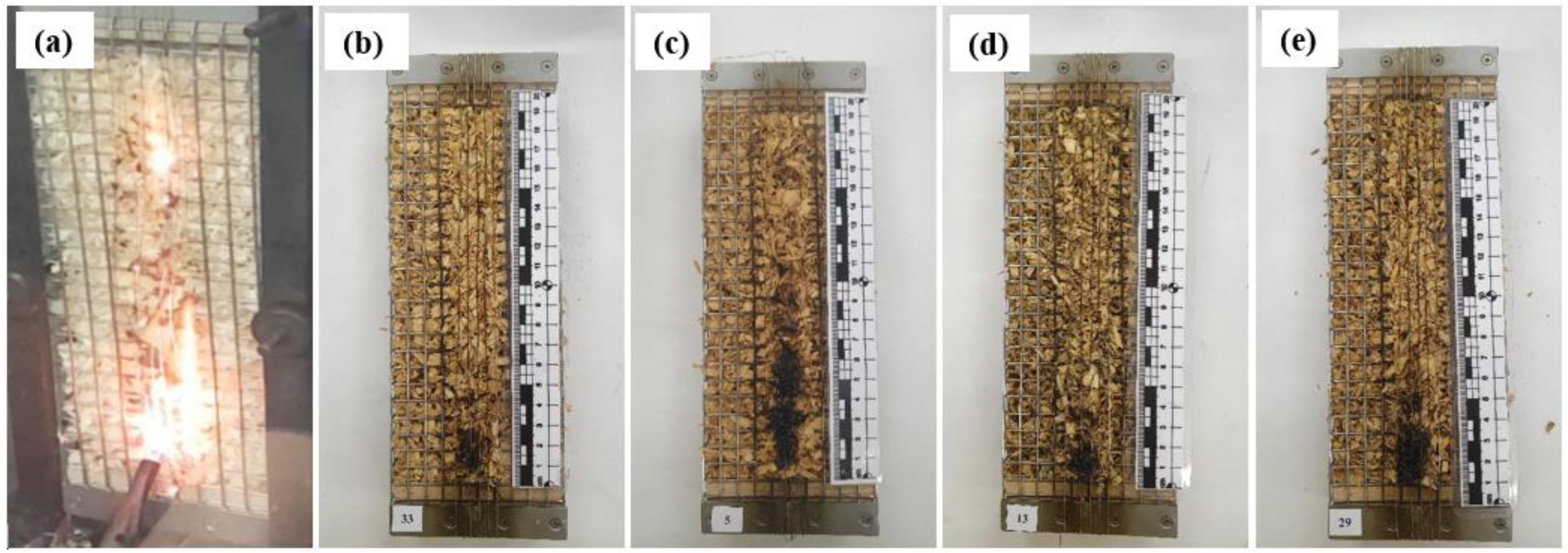
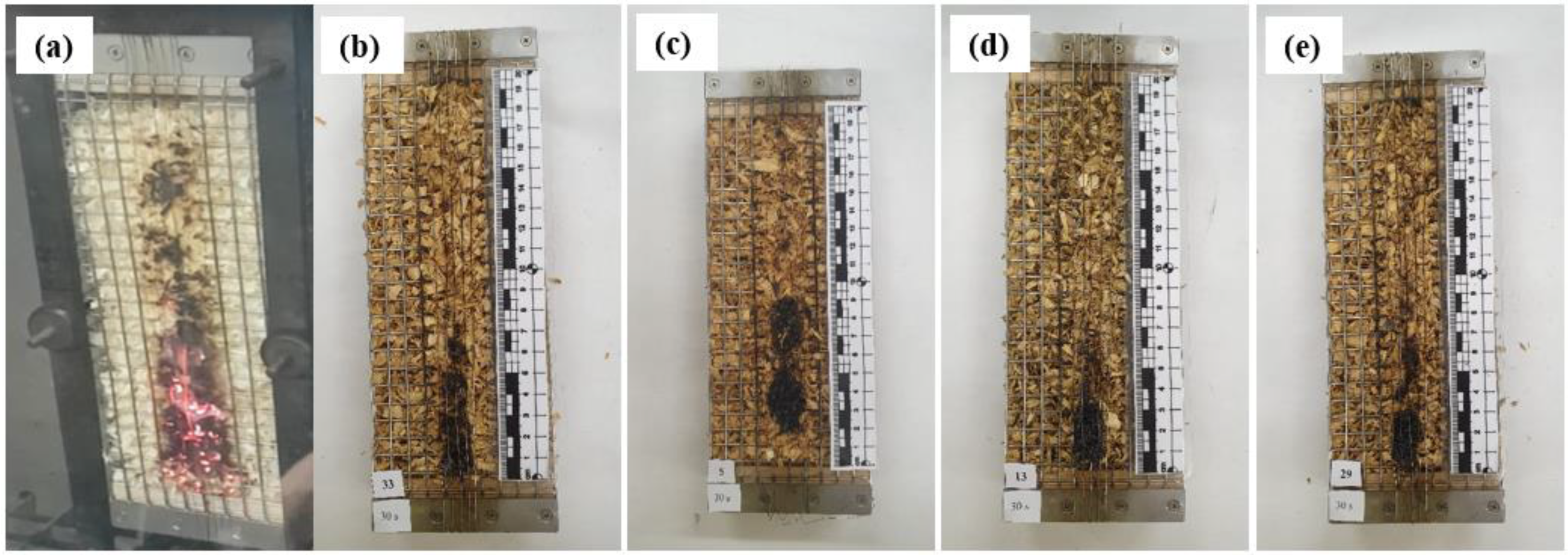


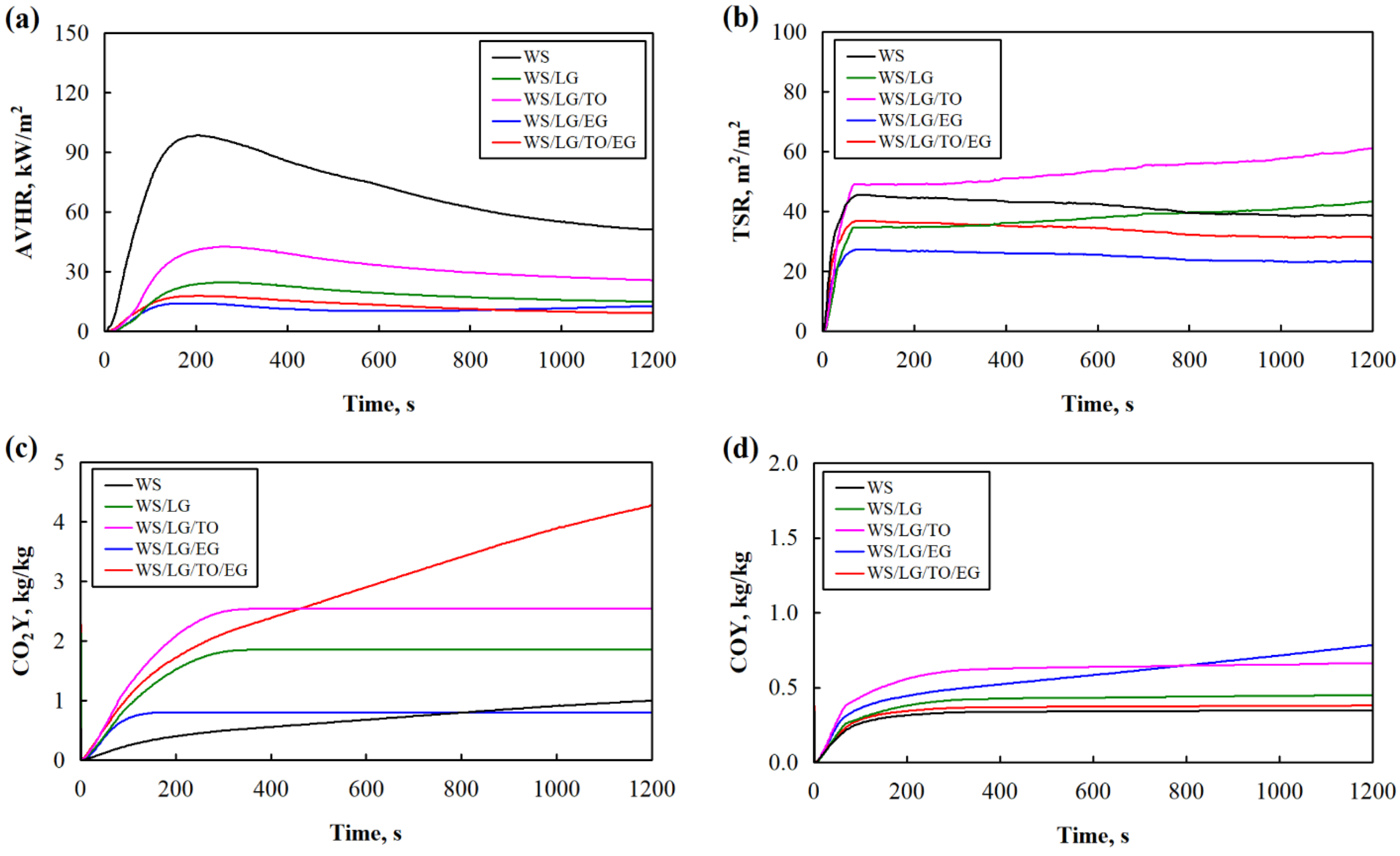
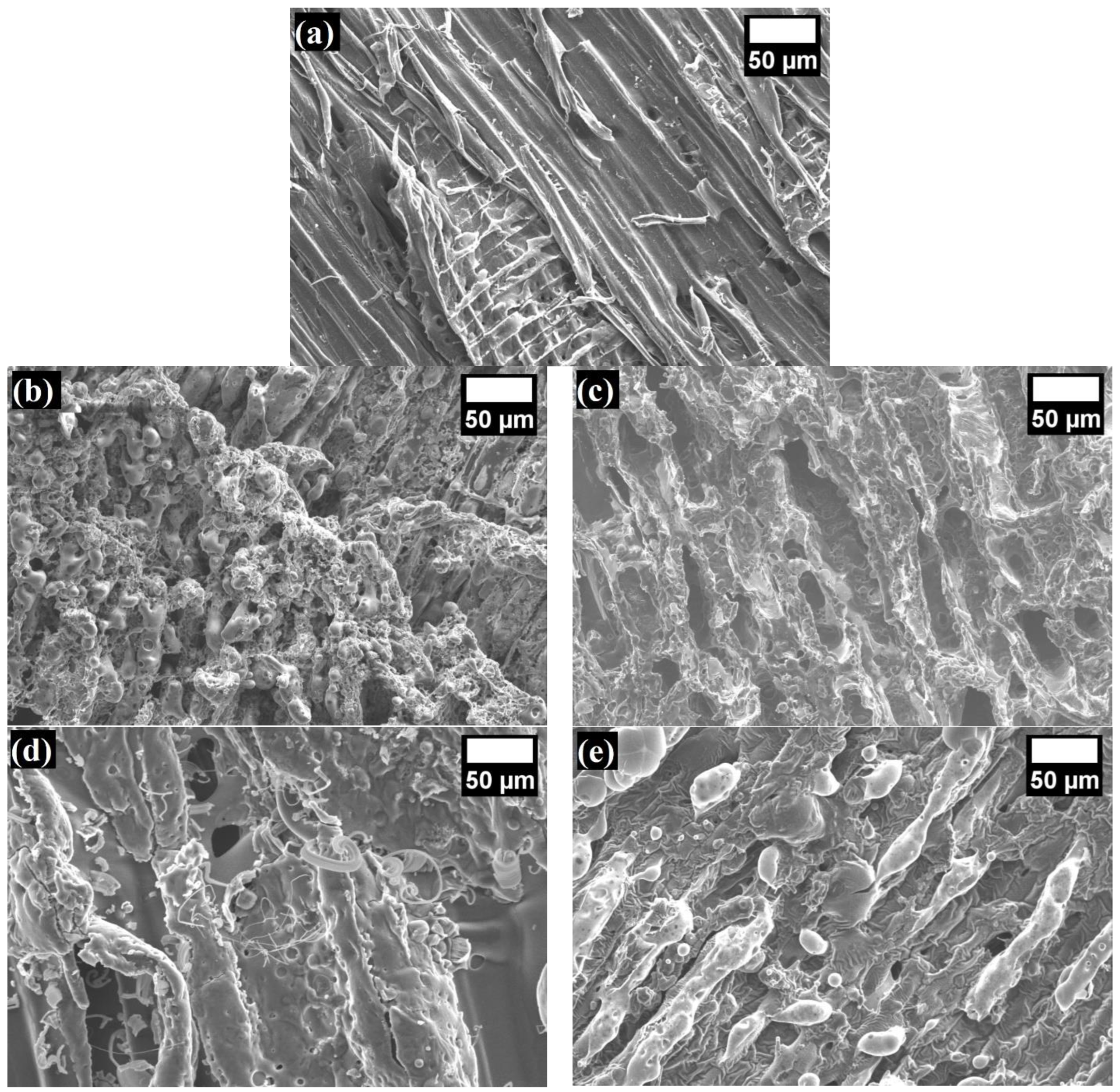
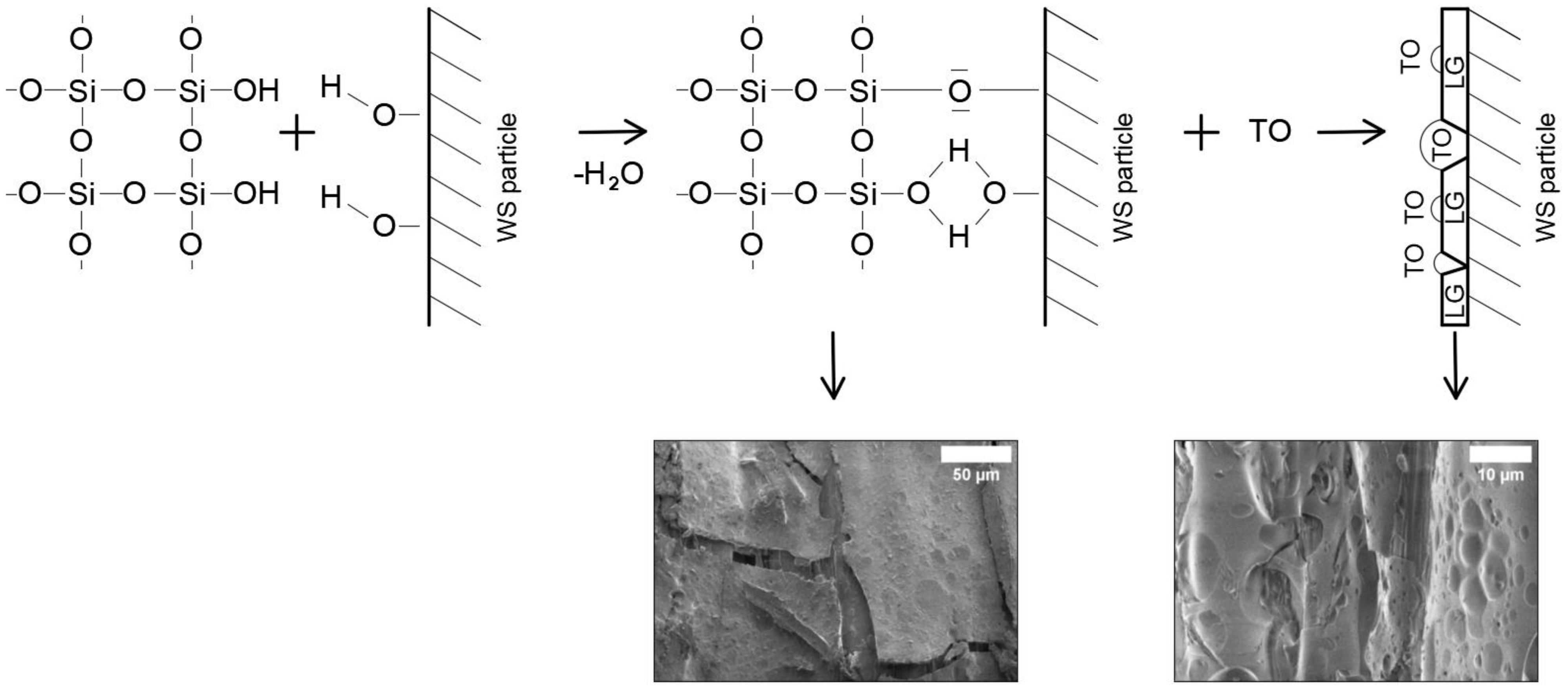
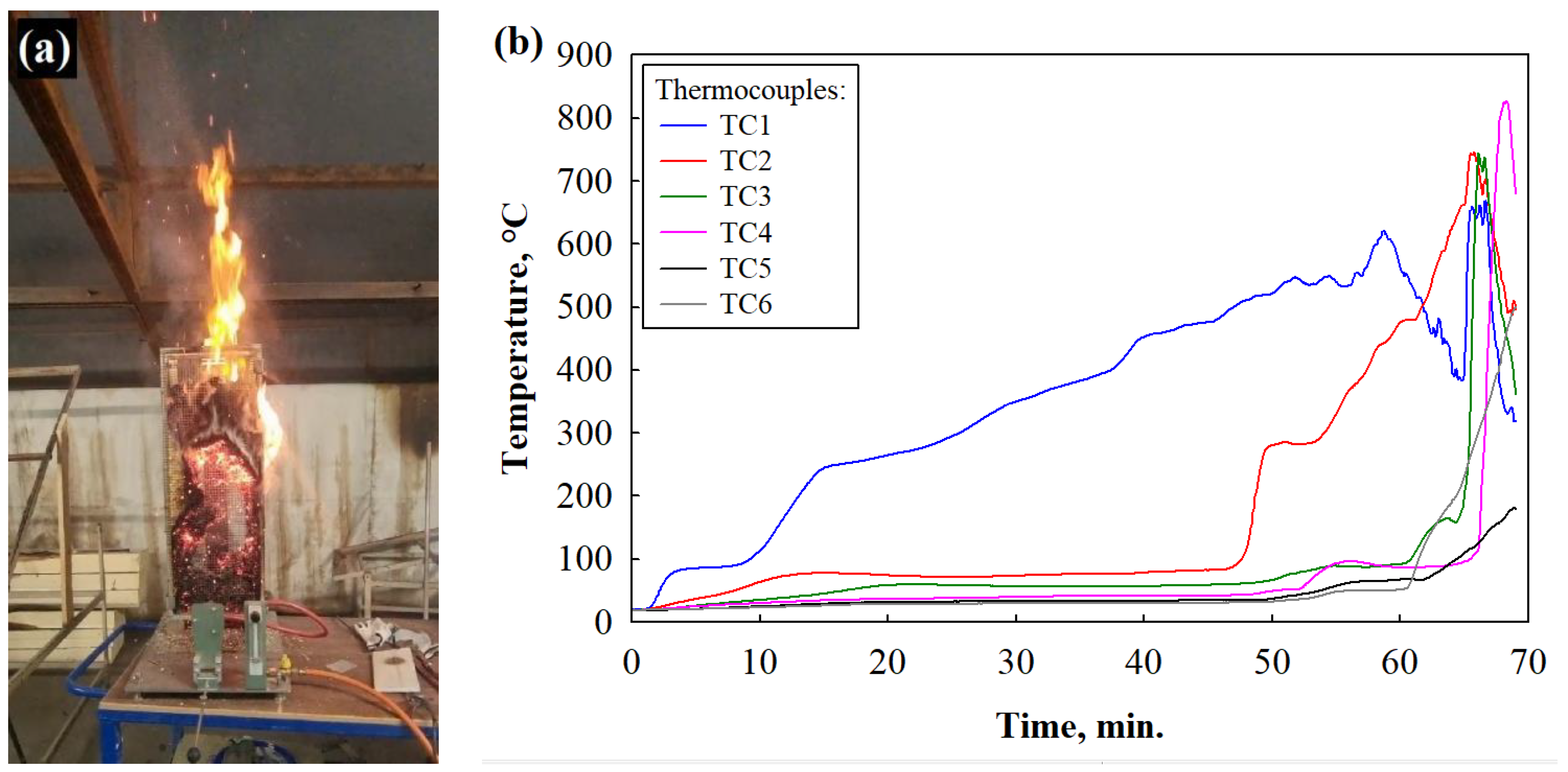
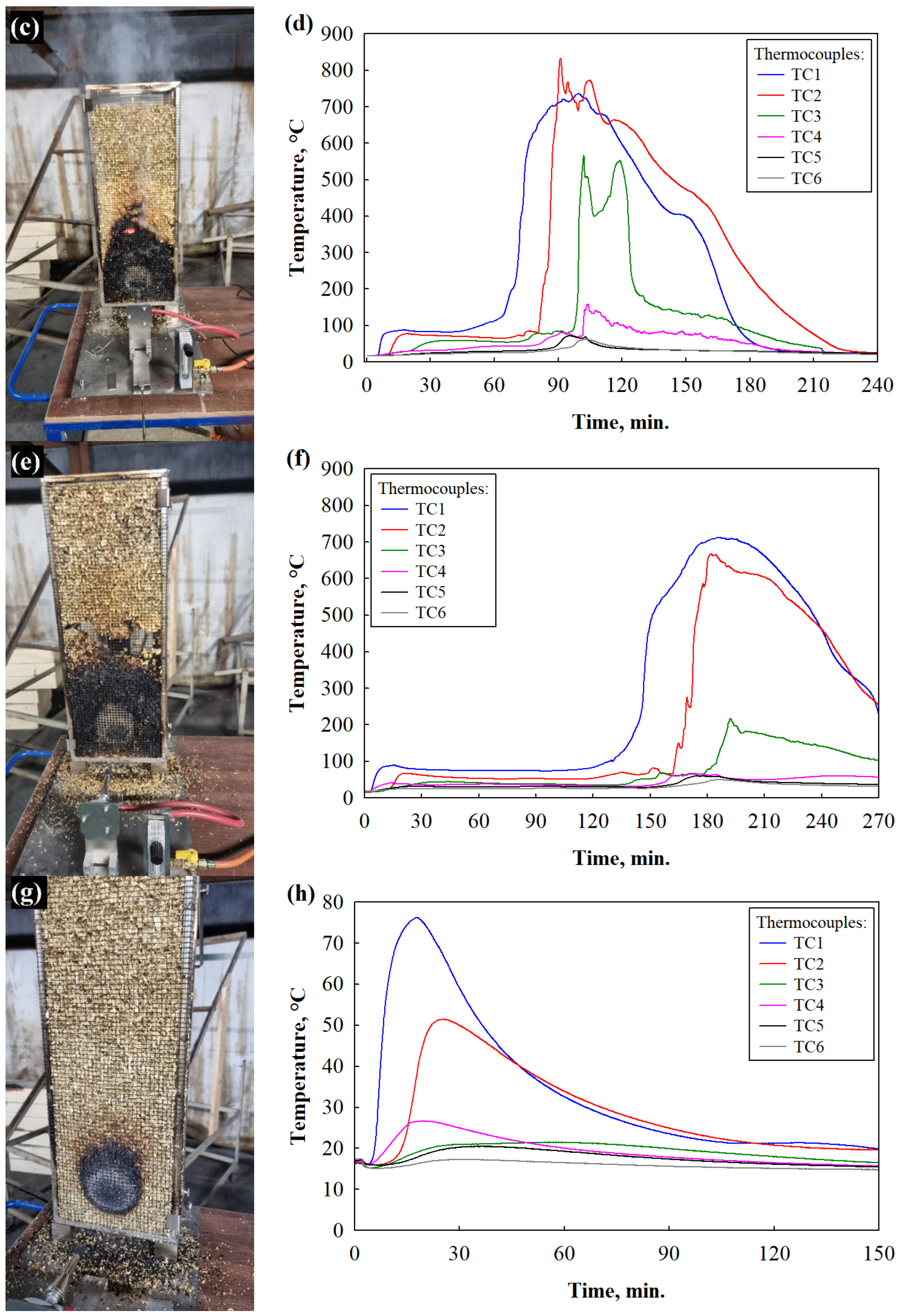
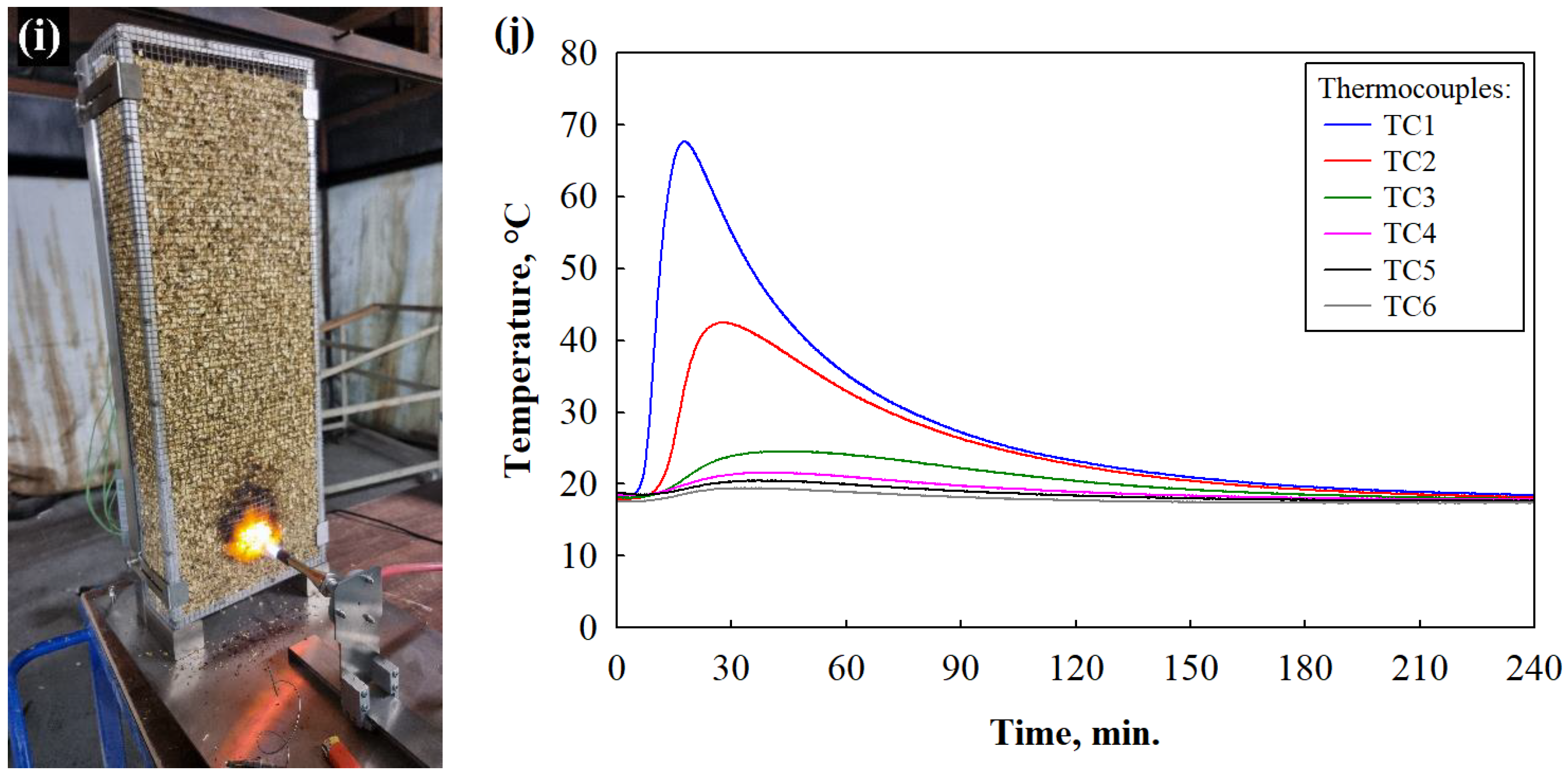
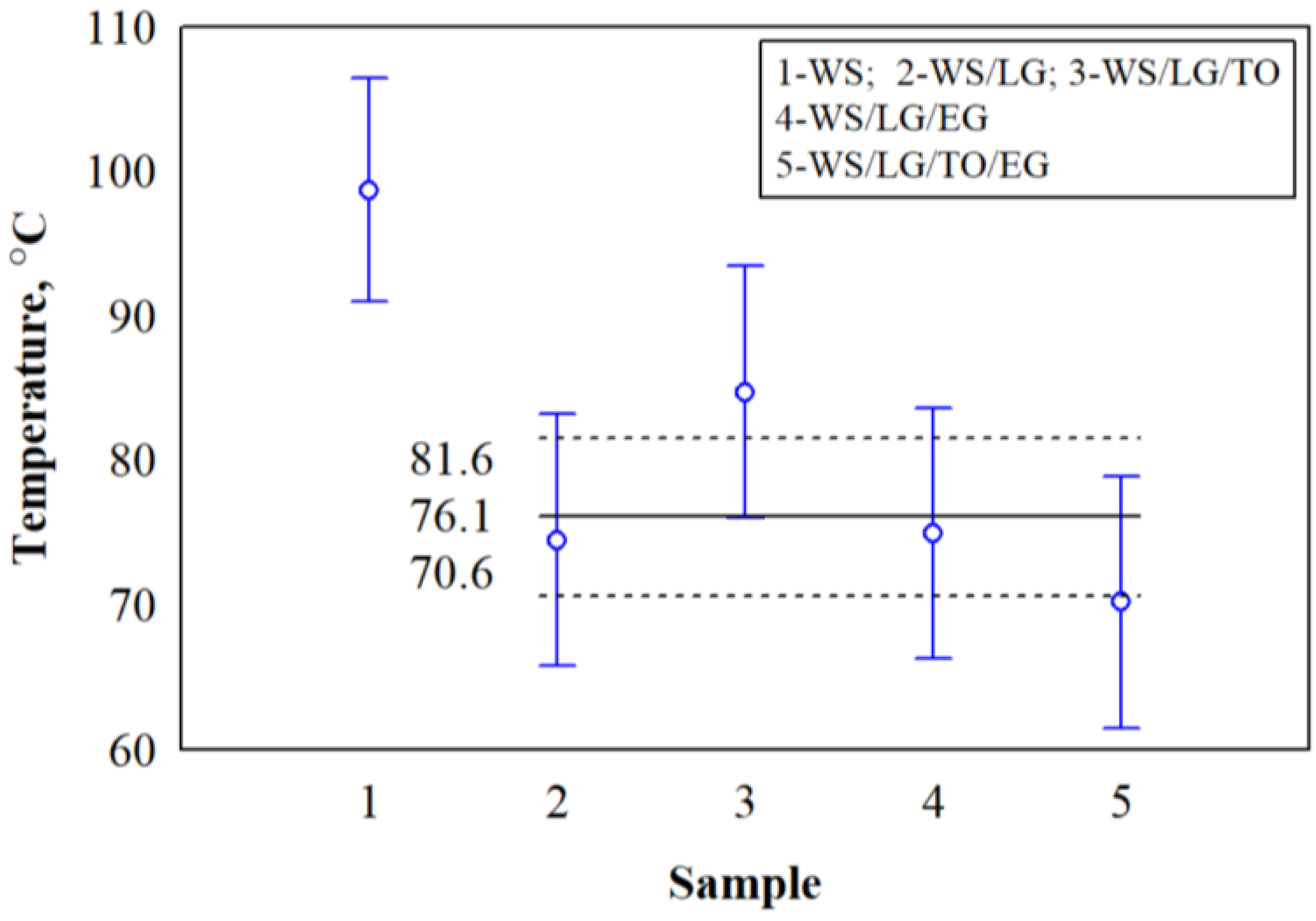
| Sample | Component, wt.% by WS | |||
|---|---|---|---|---|
| WS | LG | TO | EG | |
| WS | 100 | 0 | 0 | 0 |
| WS/LG | 100 | 100 | 0 | 0 |
| WS/LG/TO | 100 | 100 | 10 | 0 |
| WS/LG/EG | 100 | 100 | 0 | 10 |
| WS/LG/TO/EG | 100 | 100 | 10 | 10 |
| Composition | T5%, °C | T50%, °C | Tmax., °C | Char Residues at 900 °C, wt.% | |||
|---|---|---|---|---|---|---|---|
| 1 | 2 | 3 | 4 | ||||
| WS | 240 | 335 | 325 | 465 | – | – | 6.91 |
| WS/LG | 105 | 550 | 270 | 550 | – | – | 44.0 |
| WS/LG/TO | 175 | 505 | 275 | 570 | 465 | – | 33.4 |
| WS/LG/EG | 160 | 665 | 275 | 655 | – | 770 | 38.8 |
| WS/LG/TO/EG | 160 | 555 | 300 | 555 | 480 | 785 | 33.0 |
| Composition | pHRR, kW/m2 | TSR, m2/m2 | COY, kg/kg | CO2Y, kg/kg |
|---|---|---|---|---|
| WS | 98.6 ± 3.01 | 38.6 ± 4.95 | 0.35 ± 0.0404 | 1.01 ± 0.200 |
| WS/LG | 24.8 ± 1.97 | 43.5 ± 3.97 | 0.45 ± 0.0900 | 1.86 ± 0.201 |
| WS/LG/TO | 42.6 ± 3.00 | 61.2 ± 5.97 | 0.66 ± 0.0808 | 2.54 ± 0.299 |
| WS/LG/EG | 14.3 ± 2.00 | 23.3 ± 5.01 | 0.79 ± 0.0603 | 0.80 ± 0.110 |
| WS/LG/TO/EG | 18.0 ± 1.96 | 31.4 ± 2.95 | 0.38 ± 0.0400 | 4.30 ± 0.295 |
| Statistical Data | ||||
| R2 | 0.996 | 0.917 | 0.910 | 0.978 |
| Corrected R2 | 0.994 | 0.884 | 0.874 | 0.969 |
| F | 606 | 27.8 | 25.4 | 110 |
| p | 0 | 0 | 0 | 0 |
| Composition | Elemental Composition, wt.% | ||||
|---|---|---|---|---|---|
| C | O | Na | Si | S | |
| WS | 83.04 | 16.89 | 0 | 0.03 | 0.04 |
| WS/LG | 31.07 | 39.55 | 10.5 | 18.82 | 0.06 |
| WS/LG/TO | 54.71 | 34.96 | 6.63 | 3.67 | 0.03 |
| WS/LG/EG | 52.82 | 26.68 | 7.85 | 12.24 | 0.41 |
| WS/LG/TO/EG | 68.68 | 19.27 | 5.19 | 6.21 | 0.65 |
Disclaimer/Publisher’s Note: The statements, opinions and data contained in all publications are solely those of the individual author(s) and contributor(s) and not of MDPI and/or the editor(s). MDPI and/or the editor(s) disclaim responsibility for any injury to people or property resulting from any ideas, methods, instructions or products referred to in the content. |
© 2024 by the authors. Licensee MDPI, Basel, Switzerland. This article is an open access article distributed under the terms and conditions of the Creative Commons Attribution (CC BY) license (https://creativecommons.org/licenses/by/4.0/).
Share and Cite
Augaitis, N.; Vaitkus, S.; Kairytė, A.; Vėjelis, S.; Šeputytė-Jucikė, J.; Balčiūnas, G.; Kremensas, A. Research on Thermal Stability and Flammability of Wood Scob-Based Loose-Fill Thermal Insulation Impregnated with Multicomponent Suspensions. Materials 2024, 17, 2809. https://doi.org/10.3390/ma17122809
Augaitis N, Vaitkus S, Kairytė A, Vėjelis S, Šeputytė-Jucikė J, Balčiūnas G, Kremensas A. Research on Thermal Stability and Flammability of Wood Scob-Based Loose-Fill Thermal Insulation Impregnated with Multicomponent Suspensions. Materials. 2024; 17(12):2809. https://doi.org/10.3390/ma17122809
Chicago/Turabian StyleAugaitis, Nerijus, Saulius Vaitkus, Agnė Kairytė, Sigitas Vėjelis, Jurga Šeputytė-Jucikė, Giedrius Balčiūnas, and Arūnas Kremensas. 2024. "Research on Thermal Stability and Flammability of Wood Scob-Based Loose-Fill Thermal Insulation Impregnated with Multicomponent Suspensions" Materials 17, no. 12: 2809. https://doi.org/10.3390/ma17122809





